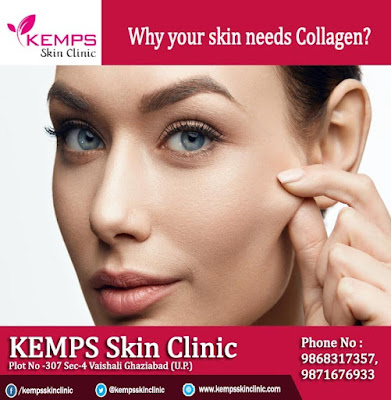“Keratosis pilaris (KP) is a common and benign disorder of
hair follicles in the skin,” says Dr Manju keshari, Senior Dermatologists
,KEMPS Skin Clinic “ It typically presents as rough 1 to 2 mm little bumps on
your skin, particularly on the backs of arms but can also affect the buttocks,
upper thighs and even cheeks. It’s often described in association with other
dry skin conditions like eczema.”
50 to 80 percent of adolescents and 40 percent of adults have keratosis pilaris, and because it’s inherited, about half of patients also have family members with the same skin condition. It’s typically at its worse during puberty and improves with age, but as with most skin conditions, it can also be affected by the changing seasons. “Keratosis pilaris improves during summer months and worsens as the skin tends to dry out during the winter,” she explains.
Gradually, keratosis pilaris usually clears up on its own. In the meantime, you might use any of the various products available to help improve the appearance of affected skin. If moisturizing and other self-care measures don't help, your doctor may prescribe medicated creams.
Home remedies:
If you want t know more about Keratosis pilaris visit KEMPS Skin Clinic , Vailshali ,Ghaziabad. Book a prior appointment for better for your comfort.
50 to 80 percent of adolescents and 40 percent of adults have keratosis pilaris, and because it’s inherited, about half of patients also have family members with the same skin condition. It’s typically at its worse during puberty and improves with age, but as with most skin conditions, it can also be affected by the changing seasons. “Keratosis pilaris improves during summer months and worsens as the skin tends to dry out during the winter,” she explains.
Gradually, keratosis pilaris usually clears up on its own. In the meantime, you might use any of the various products available to help improve the appearance of affected skin. If moisturizing and other self-care measures don't help, your doctor may prescribe medicated creams.
How to
Treat Keratosis Pilaris:
(1)
Creams to remove dead skin cells. Creams
containing alpha hydroxy acid, lactic acid, salicylic acid or urea help loosen
and remove dead skin cells. They also moisturize and soften dry skin. Depending
on their strength, these creams (topical exfoliants) are available
over-the-counter or with a prescription. Your dermetologist can advise you on
the best option and how often to apply. The acids in these creams may cause
redness, stinging or skin irritation, so they aren't recommended for young
children.
(2)
Creams to prevent plugged follicles: Creams
derived from vitamin A (topical retinoids) work by promoting cell turnover and
preventing plugged hair follicles. Tretinoin (Retin-A, Renova, Avita) and
tazarotene (Avage, Tazorac) are examples of topical retinoids. These products
can irritate and dry the skin. Also, if you're pregnant or nursing, your dermatologist may suggest delaying topical retinoid therapy or choosing
another treatment
Home remedies:
Self-help measures won't prevent keratosis pilaris or make
it go away. But they may improve the appearance of the affected skin.
1)
Use warm water and limit bath time. Hot
water and long showers or baths remove oils from the skin. Limit bath or shower
time to about 10 minutes or less. Use warm, not hot, water.
2)
Be gentle to the skin. Avoid harsh, drying
soaps. Gently remove dead skin (exfoliate) with a washcloth or loofah. Vigorous
scrubbing or removal of hair follicle plugs may irritate the skin and aggravate
the condition. After washing or bathing, gently pat or blot the skin
with a towel so that some moisture remains.
3)
Try medicated creams. Apply an
over-the-counter cream that contains urea (Nutraplus, Eucerin), lactic acid
(AmLactin, Lac-Hydrin), alpha hydroxy acid or salicylic acid. These creams help
loosen and remove dead skin cells. They also moisturize and soften dry skin.
Put on this product before moisturizer.
4)
Moisturize. While the skin is still moist
from bathing, apply a moisturizer that contains lanolin (Lansinoh, Medela),
petroleum jelly (Vaseline) or glycerin (Glysolid). These ingredients soothe dry
skin and help trap moisture. Thicker moisturizers work best, such as Eucerin
and Cetaphil. Reapply the product to the affected skin several times a day.
5)
Use a humidifier. Low humidity dries out
the skin. A portable home humidifier or one attached to your furnace will add
moisture to the air inside your home.
6)
Avoid friction from tight clothes. Protect affected skin from the friction caused by wearing tight clothes.
If you want t know more about Keratosis pilaris visit KEMPS Skin Clinic , Vailshali ,Ghaziabad. Book a prior appointment for better for your comfort.






